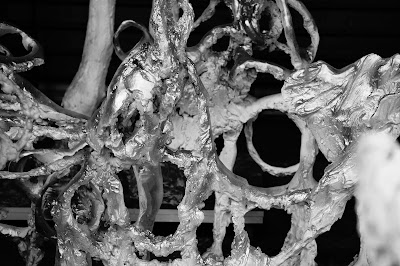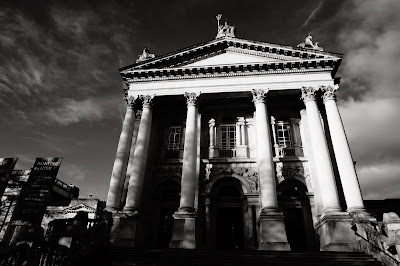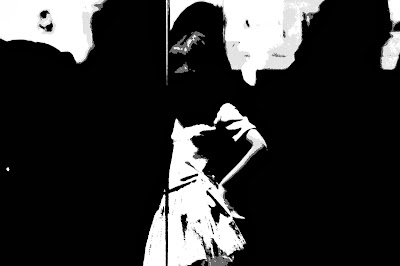by Nicole Page-Smith
Friday, 27 December 2013
Wednesday, 25 December 2013
Monday, 23 December 2013
London
It was nice to walk through the autumn leaves to the Tate Britain. Past the palace gates and past all those strange royal watchers. I quite like the new directors rehang and the inclusion of her scholarly interests. I always wondered why the Tate Britain did not house a broad ascension of the well known British sculptors. This was followed by a visit to the Queens Gallery which despite all the bad taste royal watchers souvenirs, also has some incredible exhibitions of the Queen's royal collection. On view was a really lovely exhibition of the lost genius, Castiglione. Other days were taken up by a trip to the other side of the Thames for a tete a tete or a view of the equally as interesting Klee exhibition. His delicate watercolors were well worth the view. I also like the general collection or the rooms surrounding Rothko's room. Another exhibition on view was the Daumier exhibition at the Royal Academy. It is always nice to walk around London through all there beautiful parks and gardens. The National Gallery has a very precious Renaissance ascension so it was lovely to view some of the paintings I have written about during the year. God blessing.
by Nicole Page-Smith
Sunday, 22 December 2013
Messina
After Padova, the Messina show in the Museo di arte moderna e contemporanea di Trento e Rovereto was a divine blessing. Especially the Annunciata and Cristo alla colonna. I have always wanted to see these painting and it is a divine excursion that he was born close by. His usage of perspective nominates who his teachers were. I like the idea that they were encouraged to go to a small village to make a name for themselves with an individual view or another reevaluation of Christ.
Saturday, 21 December 2013
Venice
I eventually made it to my first Venice Biennale. The exhibition was interesting to observe. With my own understanding, having read Jung in my early art career days and finding the language of the unconscious a fascinating source. The reference to early 20th century philosophy which Dada and the Surrealists first exaggerated with automatic drawing felt like it was the background for the more abstract works in the exhibition. Other highlights were the room of Fischli & Weiss ceramic pieces of unfired clay. It was interesting to follow a view of the Venice Biennale with a visit to the Peggy Guggenheim Museum. What followed Surrealism in America is echoed further in the current contemporary art of today. This collection in Peggy Guggenheim's former house in Venice is of high class works ranging from Max Ernst to Jackson Pollock to the sculpture of Mario Merz and several other European sculptors such as Henry Moore and Germaine Richier. The Accademia is also well worth a visit.
Friday, 20 December 2013
The Louvre
Eventually I found these divine offering, even though they were staring me in the face on the instruction map. I did discover these beautiful pieces in my first art book that I purchased about Gothic Sculpture 1140-1300 by Paul Williamson but would not have expected them to be anywhere other than a gothic church. So, even where they are placed in the museum would not make sense to me as they were not with the other church offerings on view and are with the divine tapestries reminiscent of the Cluny Museums offerings unto God. They should put other master works on the map so you get to imagine there is more than Mona Lisa to view. The other grouping of Leonardo da Vinci's paintings are far more appealing, even though in a different location. I enjoyed my time spent there, for as I have been to the Louvre Museum many times, I usually only have an hour to fill in and get through about half of one ascension of sculpture. They are treated like they are far too divine to view and so are almost among Christian relics from interior church altars.
Thursday, 19 December 2013
The Springtime of the Renaissance
The Springtime in the Renaissance exhibition at the Louvre was also a blessing. Several pieces were good to catch up with after writing on and studying them over the past two years. Desiderio da Settignano's, Marietta Stozzi, c. 1464 (as above and below) was one such work. Other highlights included Donatello's, Madonna and Child (Pazzi Madonna), c. 1420-1425 and Luca della Robbia's, Madonna and Child (Genoa Madonna), 1445-1450. The love and gracious line work in Donatello's relief was equally as magic in Luca della Robbia's sensitive handling of the subject. It was rewarding going to Italy and then back to Paris for another view and a beautiful experience to find other people who are as passionate about a subject as yourself.
Wednesday, 18 December 2013
The Durer exhibition
The Durer exhibition in Frankfurt was a highlight of the exhibition tour of Europe. The dark currents of the river that Stadel Museum feel reflected in come forth in this exhibition and prodigiously with the works on paper. There were several famous works often reproduced in books of Durer's worth. Unfortunately they are often the crowds understanding of what should be circled around so viewing space is limited. Happening several views are necessary and going at different times of the day can be useful. The Apocalypse series was full of the most sacred information you could possibly care to observe. His masterful trio of "St. Jerome in his Study", ca. 1514, "Melencolia I (Melancholy), ca. 1514 and "The Knight, Death, and the Devil", ca. 1513, were as close to your heart as God would allow you to go. Durer's Apostle series was also well worth the view and the darkened plates seemed to accentuate his ascension to the Lord. The accompanying works were also a very special inclusion and referenced well the philosophy of the time.
Subscribe to:
Comments (Atom)





















